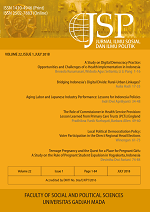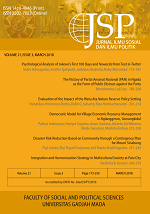Israeli-Palestinian Conflict Beyond Resolution: A Critical Assessment
Fadhila Inas Pratiwi(1*), M. Aryo Rasil Syarafi(2), Demas Nauvarian(3)
(1) Department of International Relations, Universitas Airlangga, Indonesia
(2) Department of International Relations, Universitas Airlangga, Indonesia
(3) Department of International Relations, Universitas Airlangga, Indonesia
(*) Corresponding Author
Abstract
Of all the inter-state conflict currently happening in different regions of the world, the Israel- Palestine conflict has stood the test of time to become one of the longest and most impactful. Despite numerous attempts to resolve the Israeli-Palestinian conflict, both parties have persisted, mainly showing a lack of compromise and commitment. This paper aims to analyze the underlying reason to the various unsuccessful attempts of Israel-Palestine conflict resolutions. This paper argues that there are four core issues that become object of negotiation in each attempt: borders, security, Jerusalem, and refugees. This paper assesses each party’s stances on these four issues and how they shape the negotiation process. This is done through an empirical generalization by inductive methodology, using library studies as a data collection method. This paper concludes that there should be an ideational change to compromise within the domestic politics of both parties to make future conflict resolution possible.
Keywords
Full Text:
PDFReferences
Abu Laban, Y., & Bakan, A. B. (2019). Israel, Palestine and the Politics of Race. I.B Tauris.
Abu Sway, M. (2002). Islamic Perspectives on the Oslo Process. In Robert L. Rothstein et al (Ed.), The Israeli-Palestinian Peace Process: Oslo and the Lessons of Failure. Brighton: Sussex Academic Press.
Ahmad, A. (2022). Land for Peace? Game Theory and the Strategic Impediments to a Resolution in Israel-Palestine. Defence and Peace Economics. https://doi.org/10.1080/10242694.2022.2031445
Bar-Siman-Tov, Y. (2010). Barriers to Peace in the Israeli-Palestinian Conflict. The Jerusalem Institute for Israel-Studies
Barak, O. (2005). The Failure of the Israeli-Palestinian Peace Process, 1993-2000. Journal of Peace Research, 42(6), 719–736. https://doi.org/10.1177/0022343305057889
Beauchamp, Z. (2018a). What is Jerusalem? VOX. Retrieved from https://www.vox.com/2018/11/20/18080040/jerusalem- israel-palestine
Beauchamp, Z. (2018b). What is the Nakba?VOX. Retrieved from https://www. vox.com/2018/11/20/18080030/israel- palestine-nakba
Biermann, F., & Stefan Jagdhuber. (2022). Take it and leave it! A postfunctionalist bargaining approach to the Brexit negotiations. West European Politics, 45(4), 793–815. https://doi.org/10.1080/01402382.2021.1901039
Blagden, D. (2016). Induction and Deduction in International Relations: Squaring the Circle between Theory and Evidence. International Studies Review, 18(2), 195–213. https://doi.org/10.1093/isr/viw004
Brett, J. M., & Michele J. Gelfand. (2006). A Cultural Analysis of the Underlying Assumptions of Negotiation Theory. In Leigh L. Thompson (Ed.), Negotiation Theory and Research. New York: Psychology Press.
Caplan, N. (2011). The Israel-Palestine Conflict: Contested History. Oxford: Wiley Blackwell.
Coleman, R., & Fraser, C. R. (1979). Integrative Versus Distributive Bargaining: Choosing a Problem Resolution Process. Industrial Relations, 34(3), 546–562.
Dai, L. (2021). Implementation Constraints on Israel-Palestine Water Cooperation: An Analysis Using the Water Governance Assessment Framework. Water, 13(5), 620. https://doi.org/10.3390/w13050620
Figueira, F., & Martill, B. (2020). Bounded rationality and the Brexit negotiations: why Britain failed to understand the EU. Journal of European Public Policy, 28(12), 1871–1889. https://doi.org/10.1080/13501763.2020.1810103
Fox, J., & Sandler, S. (2004). Bringing Religion into International Relations. New York: Palgrave Macmillan.
Galganek, A. (2019). Induction and Deduction in Theorizing of International Relations. Przegląd Politologiczny, (4), 39–54. https:// doi.org/10.14746/pp.2019.24.4.4
Goldberg, J. E. (1991). Understanding the Dimensions of Terrorism. Perspectives on Political Science, 20(2), 78–88. https://doi.or g/10.1080/10457097.1991.9944484
Goldenberg, I. (2015). Lessons from the 2013-2014 Israeli-Palestinian Final Status Negotiations. Center for a New American Security
Grosglik, R., Handel, M., & Monterescu, D. (2020). Soil, territory, land: The spatial politics of settler organic farming in the West Bank, Israel/Palestine. Environment and Planning D: Society and Space, 39(5), 906–924. https://doi. org/10.1177/02637758211041121
Johnson, D., & Toft, M. (2014). Grounds for War: The Evolution of Territorial Conflict. International Security, 38(3), 7–38. https:// doi.org/10.1162/ISEC_a_00149
Kaplan, R. D. (2013). The Revenge of Geography: What the Map Tells Us about Coming Conflicts and the Battle against Fate. New York: Random House.
Katrak, M., & Blanche, D. (2021). Examining the Role of Trust and Ideological Disparities in India-EU Negotiations: The Case of the Bilateral Trade and Investment Agreement (BTIA). Central European Journal of International and Security Studies, 15(4), 48–80. https://doi.org/10.51870/CEJISS.A150403
Kaufman, E. (2010). Merging the Human Rights Dimension into Peace-Making: Is It Good for the Jews? In Elizabeth G. Matthews (Ed.), The Israel-Palestine Conflict: Parallel Discourse. New York: Routledge.
Krieger, Z. (2011). Introducing a 4-Part Special Report on the Israeli-Palestinian Conflict. The Atlantic. Retrieved from https://www.theatlantic.com/ international/archive/2011/10/introducing-a-4-part- special-report-on-the-israeli-palestinian- conflict/247263/
Kurtzer, D. C., Duss, M., & Sachs, N. B. (2014). The Israeli -Palestinian Conflict: Has the U.S. Failed? 1–31.
Langenbacher, E., & Yossi, S. (2010). Power and the Past: Collective Memory and International Relations. Washington D.C: Georgetown University Press.
Ma’oz, M. (2002). The Oslo Peace Process: From Breakthrough to Breakdown. In Robert L. Rothstein et al (Ed.), The Israeli-Palestinian Peace Process: Oslo and the Lessons of Failure. Brighton: Sussex Academic Press.
Michaels, J. L. (2017). Social forces sustaining the israeli-palestinian tensions: A dynamical psychology perspective. International Journal of Conflict and Violence, 11(04), 1-13 https://doi.org/10.4119/UNIBI/ijcv.255
Miller, E. (2012). The Intractable Issue: Palestinian Refugees and the Israeli-Palestinian Peace Negotiations. Atkin Paper Series. The International Centre for the Study of the Radicalisation and Political Violence
Newman, D. (1999). Boundaries , Territory and Postmodernity. London: Frank Cass Publisher.
Newman, D., & Ghazi, F. (1997). Bridging the Gap: Palestinian and Israeli Discourses on Autonomy and Statehood. Transactions of the Institute of British Geographers, 22(1),111–129.
Niu, S., & Wu, T. (2021). Changes and Trends in the Current Relations Between Saudi Arabia and Israel. Asian Journal of Middle Eastern and Islamic Studies, 15(2), 172–188. https://doi.or g/10.1080/25765949.2021.1928413
Nusseibeh, L. (2008). Why Human Security Is Relevant to the Israeli-Palestinian Conflict. Palestine-Israel Journal of Politics, Economic and Culture, 15(3), 20-26.
Palestine Liberation Organization. (2020).Summary of Deal of The Century. Retrieved from http://www.plo.ps/en/article/163/Summary-of-Deal-of-the-Century
Pratiwi, F. I., Qomara, G., & Syarafi, M. A. R. (2020). Us involvement in the israeli- palestinian conflict: Solution or problem? Tamkang Journal of International Affairs, 24(1), 57–108. https://doi.org/10.6185/ TJIA.V.202007_24(1).0002
Quandt, W. B. (2005). Israeli-Palestinian Peace Talks: From Oslo to Camp David II. In Tamara C. Wittes (Ed.), How Israelis and Palestinians Negotiate: A Cross- Cultural Analysis of the Oslo Peace Process. Washington D.C: United States Institute for Peace Press.
Rexer, G. (2021). Borderlands of Reproduction: Bodies, Borders, and Assisted Reproductive Technologies in Israel/ Palestine. Ethnic and Racial Studies, 44(9), 1549–1568. https://doi.org/10.1080/01419870.2021.1887502
Said, E. (2000). The End of the Peace Process: Oslo and After. New York: Vintage Books.
Siniver, A. (2006). Power , Impartiality and Timing: Three Hypotheses on Third Party Mediation in the Middle East. Political Studies, 54(4), 806–826. doi/10.1111/j.1467-9248.2006.00635.x.
Siniver, A. (2012). Arbitrating the Israel- Palestine Territorial Dispute. International Politics , 49(1), 117-129 . https:/ / doi. org/10.1057/ip.2011.30
Smith, B. (2011). Hamas, Fatah, and the Middle East Quartet Principles. London: UK Parliament.
Ting-Toomey, S. (2005). Identity Negotiation Theory: Crossing Cultural Boundaries. In William B. Gudykunst (Ed.), Theorizing about Intercultural Communication. Thousand Oaks: Sage Publications.
Ulrichsen, K. C. (2018). Palestinians sidelined in saudi-emirati rapprochement with Israel. Journal of Palestine Studies, 47(4), 79–89. https://doi.org/10.1525/jps.2018.47.4.79
Yahaya, J. U. (2020). President Trump Peace Strategy: Emerging Conflict Between Israel and Palestine. International Affairs and Global Strategy, 82, 25–37. https://doi. org/10.7176/IAGS/82-04
Yiftachel, O. (2002). Territory as the Kernel of the Nation : Space, Time and Nationalism in Israel/Palestine Territory as the Kernel of the Nation: Space, Time and Nationalism in Israel/ Palestine. Geopolitics, 7(2), 215–248. https://doi.org/10.1080/714000930
Article Metrics
Refbacks
- There are currently no refbacks.
Copyright (c) 2022 Jurnal Ilmu Sosial dan Ilmu Politik

This work is licensed under a Creative Commons Attribution-NonCommercial-NoDerivatives 4.0 International License.






















